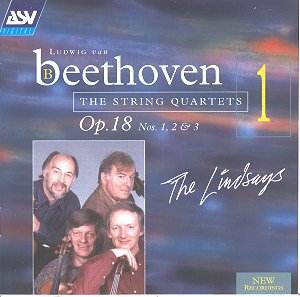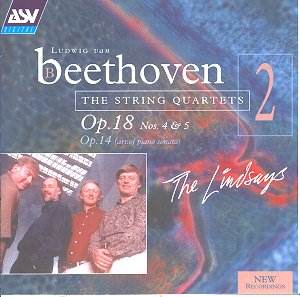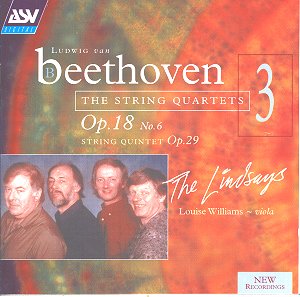BEETHOVEN Ludwig van
6 String Quartets, op.18
String Quartet in F, op.14
String Quintet in C, op.
29*
 The Lindsays, with Louise
Williams*
The Lindsays, with Louise
Williams*
 ASV CD DCA 1111-3 [3
CDs, only available separately, 76' 24", 66' 07", 58' 08"]
ASV CD DCA 1111-3 [3
CDs, only available separately, 76' 24", 66' 07", 58' 08"]

Crotchet
Amazon
UK
By mid-January 2000, when most people were still getting over their millennium
hangover, the Lindsays were hard at work on a new Beethoven cycle. With a
warm but clear recording made in Holy Trinity Church, Wentworth and very
full notes (translated into French and German) by Richard Wigmore the set
has a head's start, and the performances do not disappoint.
When a team has been playing together for some 35 years the risks, especially
in repertoire which has always been central to them, are two. On the one
hand, over-familiarity may stale their approach, while, on the other, they
may be tempted to find "new" solutions, just to do it differently from before.
The former risk can be discounted with such enquiring artists as these; the
only trace I found of the latter comes in their rather stuttering start to
the allegretto sections of the finale of no.6. The music sidles in
slowly, accelerates wildly and then drops back to what is going to be its
real tempo. Apart from this they are extremely faithful to the letter of
the score (and very generous with repeats).

Crotchet
Amazon
UK
What I do find is that, perhaps as a result of long knowledge of these works,
they seem to want to plead a special case for the "lesser" pieces. There
is an attractive reticence about their accounts of the "big" nos.1 and 4
(without any lack of vitality), but they are positively waspish with no.
2 and extremely brilliant with no. 3. They certainly emphasise the originality
and scale of these apparently unassuming quartets but a few of their tempi
seem to me just a fraction fast. The tarantella-like finale of no.3 comes
close to losing its poise at times and I was uncomfortable with the second
movement of no.4. Their tempo here is in fact (intentionally?) pretty close
to Beethoven's metronome mark but since they recognise that the markings
in the other movements need modification (that of the finale is one of
Beethoven's most manic), surely this one too, even if it is physically possible,
must be assumed to be wrong in about the same proportions?
I compared parts of all movements with the recordings by the Amadeus Quartet.
The sometimes schmaltzy quality of the Amadeus's playing of the late quartets
has got their Beethoven a bad name, but the were very fine interpreters indeed
of the op.18s. Overall they seem to find just a little more time to express
the music, and bring out a grace and a graciousness which is not out of place
in these early works. Interestingly, in no.5, the most "Mozartian" of the
group, the Lindsays produce precisely those same qualities of grace and
graciousness as the Amadeus, so it would also be possible to argue that they
have a wider range of expression, varying their approach to the work in hand.
I do very much love the Amadeus's relaxed, Schubertian way with the opening
movement of no. 6, but maybe in time I shall come to accept that the Lindsays'
energetic forward drive is more suitable to early Beethoven.

Crotchet
Amazon
UK
What is in no doubt is that I shall be coming back to these performances
often for, in spite of the odd query, they are a very fine achievement and
I want to emphasise that, even when a tempo seems a mite too fast, they never
become aggressive. And the discs gather up some extra material which most
quartet cycles omit. Pianists who have never heard Beethoven's transcription
of his op.14/1 Piano Sonata should lose no time in doing so, for they have
a fascinating experience in store. Much of the music lends itself to the
string quartet perfectly well and Beethoven need only make a straightforward
transcription such as anyone could have done. But his solutions to those
passages which are clearly unsuited to strings are fascinating and, in the
central episode of the finale, quite breathtaking. He retains his harmonic
scheme but otherwise recomposes the music entirely.
More important still is the inclusion of the op.29 Quintet. This extremely
fine work - Richard Wigmore describes it as "the crown of op.18" - is
little-known yet it provides the link between op.18 and the mould-breaking
op.59 set. The Lindsays relish its rich sonorities and in the first movement
provide not only energy but also a glorious singing quality which bodes well
for their recording of the similar movement of op.59 no.1 which will, I hope,
not be tardy in arriving. On with the next!
Christopher Howell


